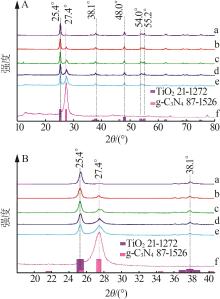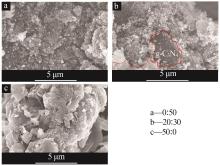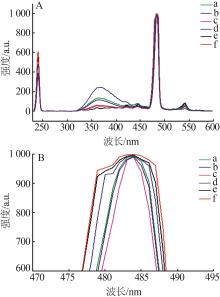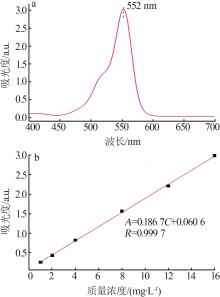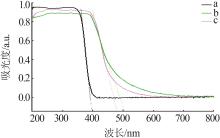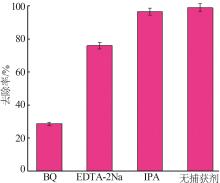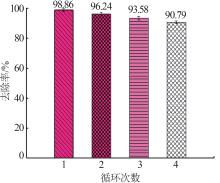Inorganic Chemicals Industry ›› 2023, Vol. 55 ›› Issue (7): 130-136.doi: 10.19964/j.issn.1006-4990.2022-0565
• O2-、h+、·OH。 • Previous Articles
Study on preparation of g-C3N4/TiO2 composites and application for rhodamine B removal
CHEN Zhangxu1,2,3( ), ZHU Danchen1,2,3, FU Minglian1,2,3
), ZHU Danchen1,2,3, FU Minglian1,2,3
- 1. College of Environmental and Biological Engineering,Putian University,Putian 351100,China
2. Fujian Provincial Key Laboratory of Ecology-Toxicological Effects & Control for Emerging Contaminants,Putian 351100,China
3. Key Laboratory of Ecological Environment and Information Atlas,Fujian Provincial University,Putian 351100,China
-
Received:2022-09-19Online:2023-07-10Published:2023-07-13
CLC Number:
Cite this article
CHEN Zhangxu, ZHU Danchen, FU Minglian. Study on preparation of g-C3N4/TiO2 composites and application for rhodamine B removal[J]. Inorganic Chemicals Industry, 2023, 55(7): 130-136.
share this article
Table 3
L16(45) orthogonal test table of adsorption of rhodamine B dye by composites"
实验 编号 | A (光照时 间)/min | B [m(g-C3N4): m(TiO2)] | C(RhB初始质量浓度)/(mg·L-1) | D(复合材 料投加量)/ (g·L-1) | E (pH) | 去除率/% |
|---|---|---|---|---|---|---|
| 1 | 45 | 10:40 | 10.0 | 1.0 | 5.50 | 70.96 |
| 2 | 45 | 20:30 | 20.0 | 2.0 | 6.00 | 95.00 |
| 3 | 45 | 30:20 | 50.0 | 3.0 | 6.50 | 83.12 |
| 4 | 45 | 40:10 | 100.0 | 4.0 | 7.00 | 37.65 |
| 5 | 90 | 10:40 | 20.0 | 3.0 | 7.00 | 94.35 |
| 6 | 90 | 20:30 | 10.0 | 4.0 | 6.50 | 94.98 |
| 7 | 90 | 30:20 | 100.0 | 1.0 | 6.00 | 48.49 |
| 8 | 90 | 40:10 | 50.0 | 2.0 | 5.50 | 78.53 |
| 9 | 180 | 10:40 | 50.0 | 4.0 | 6.00 | 91.33 |
| 10 | 180 | 20:30 | 100.0 | 3.0 | 5.50 | 76.29 |
| 11 | 180 | 30:20 | 10.0 | 2.0 | 7.0 | 94.62 |
| 12 | 180 | 40:10 | 20.0 | 1.0 | 6.50 | 93.87 |
| 13 | 270 | 10:40 | 100.0 | 2.0 | 6.50 | 45.94 |
| 14 | 270 | 20:30 | 50.0 | 1.0 | 7.00 | 64.57 |
| 15 | 270 | 30:20 | 20.0 | 4.0 | 5.50 | 55.39 |
| 16 | 270 | 40:10 | 10.0 | 3.0 | 6.00 | 60.27 |
| k1 | 71.68 | 75.65 | 80.21 | 69.47 | 70.29 | |
| k2 | 79.09 | 82.71 | 84.65 | 78.52 | 73.77 | |
| k3 | 89.03 | 70.41 | 79.39 | 78.51 | 79.48 | |
| k4 | 56.54 | 67.58 | 52.09 | 69.84 | 72.80 | |
| R | 32.49 | 15.13 | 32.56 | 9.05 | 9.19 | |
| 因素主次 C、A、B、E、D | ||||||
| 最适宜方案 A3B2C2D2E3 | ||||||
Table 4
Comparative treatment of rhodamine B simulated printing and dyeing wastewater under optimal conditions"
| 代号 | m(g-C3N4): m(TiO2) | RhB初始质量 浓度/(mg·L-1) | 复合材料投 加量/(g·L-1) | pH | 暗反应 | 光降解 | |||
|---|---|---|---|---|---|---|---|---|---|
| 吸附时间/min | 吸附率/% | 光照时间/min | 去除率/% | ||||||
| CNTO23 | 20:30 | 20.0 | 2.0 | 6.50 | 1 440 | 9.41 | 180 | 98.86 | |
| CNTO05 | 0:50 | 20.0 | 2.0 | 6.50 | 1 440 | 8.52 | 180 | 89.71 | |
| CNTO50 | 50:0 | 20.0 | 2.0 | 6.50 | 1 440 | 9.76 | 180 | 52.27 | |
| 1 | SAMANTA M, MUKHERJEE M, GHORAI U K,et al.Room temperature processed copper phthalocyanine nanorods:A potential sonophotocatalyst for textile dye removal[J].Materials Research Bulletin,2020,123:110725. |
| 2 | YAO Yuan, SUN Mingxuan, YUAN Xiaojiao,et al.One-step hydrothermal synthesis of N/Ti3+ co-doping multiphasic TiO2/BiOBr heterojunctions towards enhanced sonocatalytic performance[J].Ultrasonics Sonochemistry,2018,49:69-78. |
| 3 | WANG Zhenjun, HUANG Jiehao.Research on removing reservoir core water sensitivity using the method of ultrasound-chemical agent for enhanced oil recovery[J].Ultrasonics Sonochemistry,2018,42:754-758. |
| 4 | MODWI A, KHEZAMI L, GHONIEM M G,et al.Superior removal of dyes by mesoporous MgO/g-C3N4 fabricated through ultrasound method:Adsorption mechanism and process modeling[J].Environmental Research,2022,205:112543. |
| 5 | 韩布兴.耐高温赤铁矿(α-Fe2O3)型氧化铁纳米管阵列的可控制备[J].物理化学学报,2017,33(5):865-866. |
| HAN Buxing.Controllable preparation of iron oxide nanotube arrays with high temperature-resistant hematite(α-Fe2O3)[J].Acta Physico-Chimica Sinica,2017,33(5):865-866. | |
| 6 | 杨森林.静电技术去除氨法脱硫中气溶胶的研究[D].广州:华南理工大学,2017. |
| YANG Senlin.Study on removal of aerosol in ammonia desulfurization by electrostatic technology[D].Guangzhou:South China University of Technology,2017. | |
| 7 | 栾云博.纳米TiO2光催化剂无机酸改性及有机污染物降解效能机制[D].哈尔滨:哈尔滨工业大学,2014. |
| LUAN Yunbo.Inorganic acid modification of nano-TiO2 photocatalyst and degradation mechanism of organic pollutants[D].Harbin:Harbin Institute of Technology,2014. | |
| 8 | SONG Gaixue, CHU Zhenyu, JIN Wanqin,et al.Enhanced performance of g-C3N4/TiO2 photocatalysts for degradation of organic pollutants under visible light[J].Chinese Journal of Chemical Engineering,2015,23(8):1326-1334. |
| 9 | PAN Jinbo, SHEN Sheng, ZHOU Wei,et al.Recent progress in photocatalytic hydrogen evolution[J].Acta Physico-Chimica Sinica,2020,36(3):1905068. |
| 10 | LI Jiabi, WU Xi, LIU Shengwei.Fluorinated TiO2 hollow photocatalysts for photocatalytic applications[J].Acta Physico Chimica Sinica,2021,37(6):2009038. |
| 11 | DU Shiwen, LIAN Juhong, ZHANG Fuxiang.Visible light-responsive N-doped TiO2 photocatalysis:Synthesis,characterizations,and applications[J].Transactions of Tianjin University,2022,28(1):33-52. |
| 12 | DLAMINI M C, MAUBANE-NKADIMENG M S, MOMA J A.The use of TiO2/clay heterostructures in the photocatalytic remediation of water containing organic pollutants:A review[J].Journal of Environmental Chemical Engineering,2021,9(6):106546. |
| 13 | VERMA V, AL-DOSSARI M, SINGH J,et al.A review on green synthesis of TiO2 NPs:Photocatalysis and antimicrobial applications[J].Polymers,2022,14(7):1444. |
| 14 | FUJISHIMA A, HONDA K.Electrochemical photolysis of water at a semiconductor electrode[J].Nature,1972,238(5358):37-38. |
| 15 | LIAN Xiaoxue, LI Yan, ZOU Yunling,et al.High vis-light photocatalytic property of g-C3N4 on four pollutants(RhB,MB,TC-HCl and p-Nitrophenol)[J].Current Applied Physics,2022,39:196-204. |
| 16 | LI Yue, CHENG Dandan, LUO Yan,et al.Coaxial Fe2O3/TiO2 nanotubes for enhanced photo-Fenton degradation of electron-deficient organic contaminant[J].Rare Metals,2021,40(12):3543-3553. |
| 17 | ZHANG Yao, YUAN Jingshu, DING Yunji,et al.Research progress on g-C3N4-based photocatalysts for organic pollutants degradation in wastewater:From exciton and carrier perspectives[J].Ceramics International,2021,47(22):31005-31030. |
| 18 | ZHANG Bin, HE Xu, YU Chengze,et al.Degradation of tetracycline hydrochloride by ultrafine TiO2 nanoparticles modified g-C3N4 heterojunction photocatalyst:Influencing factors,products and mechanism insight[J].Chinese Chemical Letters,2022,33(3):1337-1342. |
| 19 | 张洁,田景芝,郝欣,等.CDs/ZnO/g-C3N4三元组分协同作用促进光催化降解染料[J].精细化工,2019,36(7):1439-1445. |
| ZHANG Jie, TIAN Jingzhi, HAO Xin,et al.Synergistic effect of CDs/ZnO/g-C3N4 ternary component for photocatalytic degradation of dyes[J].Fine Chemicals,2019,36(7):1439-1445. | |
| 20 | GHOSH U,PAL A.Fabrication of a novel Bi2O3 nanoparticle impregnated nitrogen vacant 2D g-C3N4 nanosheet Z scheme photocatalyst for improved degradation of methylene blue dye under LED light illumination[J].Applied Surface Science,2020,507:144965. |
| 21 | MA Dong, XIN Yanjun, GAO Mengchun,et al.Fabrication and photocatalytic properties of cationic and anionic S-doped TiO2 nanofibers by electrospinning[J].Applied Catalysis B:Environmental,2014,147:49-57. |
| 22 | 安伟佳,徐子怡,邵化旭,等.g-C3N4/TiO2复合光催化剂制备及活性研究[J].无机盐工业,2019,51(4):81-85. |
| AN Weijia, XU Ziyi, SHAO Huaxu,et al.Preparation and activity of g-C3N4/TiO2 composite photocatalyst[J].Inorganic Chemicals Industry,2019,51(4):81-85. | |
| 23 | ZIMBONE M, CANTARELLA M, SFUNCIA G,et al.Low-temperature atomic layer deposition of TiO2 activated by laser annealing:Applications in photocatalysis[J].Applied Surface Science,2022,596:153641. |
| 24 | JUSTINABRAHAM R, DURAIRAJ A, RAMANATHAN S,et al.Efficient degradation of emerging organic pollutant by cerium phosphate/g-C3N4/Vis/PMS system:Catalytic kinetics and toxicity evaluation[J].Diamond and Related Materials,2022,126:109067. |
| 25 | 孙海杰,刘欣改,陈志浩,等.BiOI/g-C3N4光催化降解甲基橙研究[J].无机盐工业,2021,53(4):90-94. |
| SUN Haijie, LIU Xingai, CHEN Zhihao,et al.Study on photocatalytic degradation of methyl orange by BiOI/g-C3N4 [J].Inorganic Chemicals Industry,2021,53(4):90-94. | |
| 26 | 史磊,王晗,廖剑祥,等.不同液体环境对PAN/TiO2纤维膜的催化效率影响探究[J].应用化工,2021,50(11):3061-3064,3068. |
| SHI Lei, WANG Han, LIAO Jianxiang,et al.The effect of different liquid environment on the catalytic efficiency of PAN/TiO2 fiber membrane[J].Applied Chemical Industry,2021,50(11):3061-3064,3068. | |
| 27 | 王鹏,高其乾,段良升,等.类石墨相氮化碳的制备及可见光催化性质研究[J].长春工业大学学报,2016,37(4):313-316. |
| WANG Peng, GAO Qiqian, DUAN Liangsheng,et al.Preparation of graphitic carbon nitride and its visible-light photoactivities[J].Journal of Changchun University of Technology,2016,37(4):313-316. | |
| 28 | 高敏,王蒙,肖霞,等.TiO2/g-C3N4复合物的光催化性能测试及机理研究[J].西北大学学报(自然科学版),2018,48(1):71-77. |
| GAO Min, WANG Meng, XIAO Xia,et al.TiO2/g-C3N4 composites performed ophotocatalysis and the deduction of enhanced mechanism[J].Journal of Northwest University(Natural Science Edition),2018,48(1):71-77. |
| [1] | TANG Bei. Preparation of ZnO/g-C3N4 heterojunction photocatalytic material and its degradation of pyridine [J]. Inorganic Chemicals Industry, 2024, 56(4): 133-142. |
| [2] | ZHAN Hongren, TIAN Feng, ZHANG Xianzhen, MA Yugui, KOU Liping, LIU Peng. Experimental study on preparation of high performance foam glass ceramics from waste rock wool [J]. Inorganic Chemicals Industry, 2024, 56(1): 96-101. |
| [3] | SUN Haijie, CHENG Yuan, TIAN Yuan, LIU Hongyan, CHEN Zhihao. Preparation of BiOI/g-C3N4 catalyst and its photocatalytic degradation performance of Rhodamine B [J]. Inorganic Chemicals Industry, 2023, 55(8): 36-44. |
| [4] | SONG Zhijia, WANG Suisui, KUANG Qin. Hollow Cu-doped TiO2 for enhancing photocatalytic CO2 reduction performance [J]. Inorganic Chemicals Industry, 2023, 55(8): 45-50. |
| [5] | FENG Bin, LIU Xiaofeng, YAO Pengfei, LIANG Meiqi, LONG Jinqiao, CUI Liansheng. Syudy on synthesis and properties of white light SrMoO4:Eu3+,K+@g-C3N4 phosphors [J]. Inorganic Chemicals Industry, 2023, 55(8): 95-101. |
| [6] | LIU Rui, GAO Wei, ZHANG Wenjing, AN Hongxue, LI Zaixing. Catalytic degradation of Rhodamine B by ferroferric oxide-loaded bacterial residue biochar [J]. Inorganic Chemicals Industry, 2023, 55(4): 111-119. |
| [7] | XU Xiaobing,LI Xu,YANG Xu,XU Xiaoyong. Effect of firing temperature on properties of MgO-TiO2 composite inorganic ceramic microfilter membrane support [J]. Inorganic Chemicals Industry, 2022, 54(8): 85-89. |
| [8] | YANG Shuang,ZHAO Siqin,YANG Huiying. Research progress on photocatalysis by bismuth?based semiconductor composite TiO2 [J]. Inorganic Chemicals Industry, 2022, 54(6): 38-45. |
| [9] | HOU Yan,GAO Chengjuan,WU Xizhe,ZI Xuechi,XIE Lu,YANG Haizheng,YAN Yuxing. Theoretical study on effect of nitrogen doping on photoelectric properties of rutile TiO2 [J]. Inorganic Chemicals Industry, 2022, 54(6): 90-95. |
| [10] | CHEN Xiudong,ZHANG Yihuan,ZHANG Haodong,SHENG Donghe,WU Jiawei,LIU Jinhang,YAN Ping,ZHAN Changchao. Degradation of rhodamine B by β-FeOOH modified montmorillonite compounded with H2O2 [J]. Inorganic Chemicals Industry, 2022, 54(5): 116-120. |
| [11] | ZHANG Farong,FAN Tiantian,GUO Yanyun,LI Lu,LIU Bingguang,LI Jiansheng. Research progress on self-cleaning film materials [J]. Inorganic Chemicals Industry, 2022, 54(4): 74-80. |
| [12] | FU Yong,XU Wenqi,ZHAO Qiang,RAN Ruiquan,LI Jun,JIN Yang. Study on preparation of silver-doped titanium dioxide/activated carbon composite material and its photocatalytic performance [J]. Inorganic Chemicals Industry, 2022, 54(2): 117-122. |
| [13] | GUAN Zhiyuan,ZHANG Xiaowei,WANG Mitang,ZHANG Dongliang,ZHU Changle. Effect of rare earth element of Ce and Nd co-doped with zinc oxide on photocatalytic performance of degradation of Rhodamine B [J]. Inorganic Chemicals Industry, 2022, 54(10): 155-162. |
| [14] | Wang Lixia,Ren Dongmei,Wang Qiong,Chang Chun. Stduy on preparation of magnetic metal-organic frame materials and their adsorption properties [J]. Inorganic Chemicals Industry, 2021, 53(9): 46-50. |
| [15] | Liu Xingyu,Jia Yuanyuan,Wu Shufeng,Tang Zhonghua,Zhang Peng,Liu Junqiang,Pu Xin. Research progress of Ce-based SCR denitration catalysts [J]. Inorganic Chemicals Industry, 2021, 53(8): 15-20. |
| Viewed | ||||||
|
Full text |
|
|||||
|
Abstract |
|
|||||
|
||
